Page No. 106
Q: Take a piece of square paper and fold it in different ways. Now, on the creases formed by the folds, draw lines using a pencil and a scale. You will notice different lines on the paper. Take any pair of lines and observe their relationship with each other.
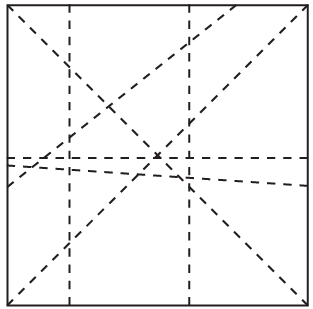
Do they meet? If they do not meet within the paper, do you think they would meet if they were extended beyond the paper?
Ans: Some pairs of lines meet at a point on the paper, forming intersecting lines. Others do not meet within the paper. If extended beyond the paper, some non-meeting lines may intersect outside the paper, while others, if parallel, will never meet.
Let us observe what happens when two lines intersect.
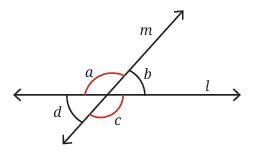
Q1: How many angles do they form?
Ans: When two lines intersect, they form four angles.
Page No. 107
Q2: Can two straight lines intersect at more than one point?
Ans: No, two straight lines can only intersect at one point. If they are parallel, they never intersect. But if two lines appear to intersect at more than one point, it means they are the same
Q3: What patterns do you observe among these angles?
Ans: The four angles formed by intersecting lines show that opposite angles (vertically opposite) are equal, and adjacent angles (linear pairs) add up to 180°.
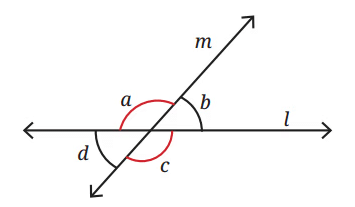
Q4: In given figure, if ∠a is 120°, can you figure out the measurements of ∠b, ∠c, and ∠d, without drawing and measuring them?
Ans: ∠b = 180° – ∠a = 180° – 120° = 60° (linear pair).
∠c = ∠a = 120° (vertically opposite).
∠d = ∠b = 60° (vertically opposite).
Q5: Is this always true for any pair of intersecting lines?
Ans: Yes, for any pair of intersecting lines, vertically opposite angles are equal, and linear pairs add up to 180°.
Page No. 108
Figure it Out

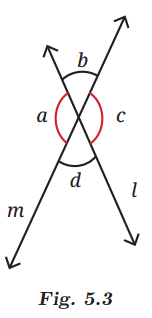
Q1: List all the linear pairs and vertically opposite angles you observe in Fig. 5.3:Ans: Linear Pairs: These are angles that are adjacent and form a straight line (add up to 180°).
- ∠a and ∠b
- ∠b and ∠c
- ∠c and ∠d
- ∠d and ∠a
Vertically Opposite Angles: These are angles that are opposite each other when two lines intersect (they are equal).
- ∠b and ∠d (they are opposite each other at the intersection).
- ∠a and ∠c (they are opposite each other at the intersection).
Page No. 110
Observe Fig. 5.5 and describe the way the line segments meet or cross each other in each case, with appropriate mathematical words (a point, an endpoint, the midpoint, meet, intersect) and the degree measure of each angle.
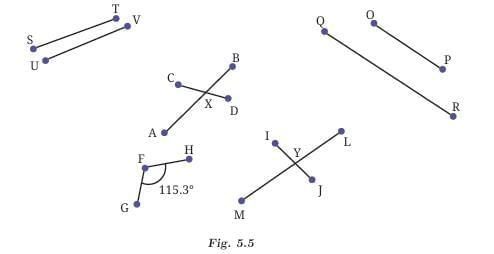
For example, line segments FG and FH meet at the endpoint F at an angle 115.3°.
Are line segments ST and UV likely to meet if they are extended?
Ans: If the lines are not parallel, they will likely intersect at some point. Thus, line segments ST and UV are likely to meet when extended, as they are not parallel.
Are line segments OP and QR likely to meet if they are extended?
Ans: If two lines are parallel, they will never meet, regardless of how far they are extended. Thus, line segments OP and QR didn’t meet when extended, as they are parallel.

Q1: What is common to the lines in the pictures below?Ans: The common thing is that the lines in all the pictures are parallel. They do not intersect each other. For example, the keys on the piano, the bars on the bench, and the layers in the wall are all parallel lines.
Q2: Name some parallel lines you can spot in your classroom.
Ans: Examples include edges of a blackboard, opposite sides of a window frame, or lines on ruled paper.
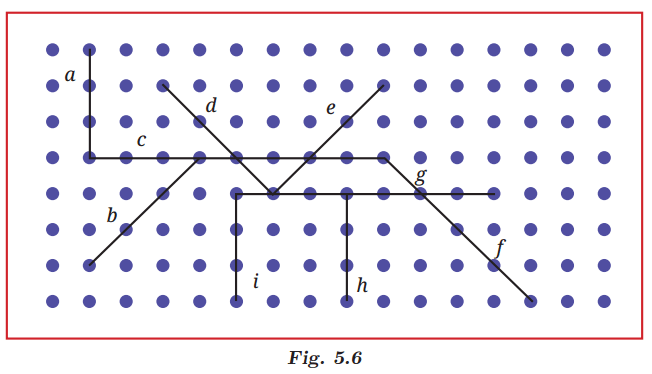
Q3: Which pairs of lines appear to be parallel in Fig. 5.6 below?Ans: Two lines are said to be parallel when they do not meet at any point.
Here, lines a, i, and h are parallel to each other;
Line c is parallel to line g;
Line d is parallel to line f;
Line e is parallel to line b.
Page No. 111
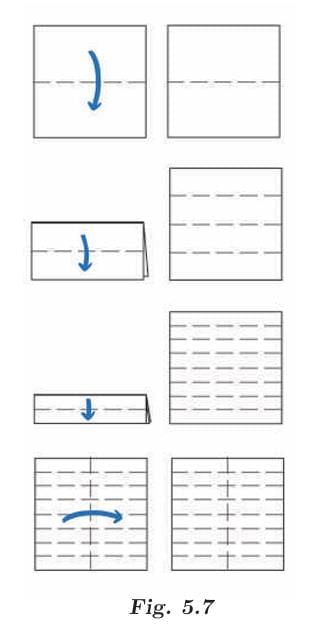
Take a plain square sheet of paper (use a newspaper for this activity).
Q1: How would you describe the opposite edges of the sheet? They are __________to each other.
Ans: The opposite edges of the sheet are parallel to each other.
Q2: How would you describe the adjacent edges of the sheet? The adjacent edges are __________ to each other. They meet at a point. They form right angles.
Ans: The adjacent edges are perpendicular to each other. They meet at a point and form right angles (90°).
Q3: Fold the sheet horizontally in half. A new line is formed. How many parallel lines do you see now? How does the new line segment relate to the vertical sides?
Ans: After folding horizontally, there are two parallel lines (the new crease and one horizontal edge). The new line segment is parallel to the horizontal edges and perpendicular to the vertical sides.
Q4: Make one more horizontal fold in the folded sheet. How many parallel lines do you see now?
Ans: After another horizontal fold, there are three parallel lines (two creases and one horizontal edge).
Q5: What will happen if you do it once more? How many parallel lines will you get? Is there a pattern? Check if the pattern extends further, if you make another horizontal fold.
Ans: Another fold creates four parallel lines. The pattern is: each horizontal fold adds one more parallel line. With n folds, there are n+1 parallel lines.
Q6: Make a vertical fold in the square sheet. This new vertical line is to the previous horizontal lines.
Ans: The new vertical line is perpendicular to the previous horizontal lines.
Q7: Fold the sheet along a diagonal. Can you find a fold that creates a line parallel to the diagonal line?
Ans: Folding the sheet parallel to the diagonal (e.g., by aligning edges to the diagonal crease) creates a line parallel to the diagonal.
Page No. 112
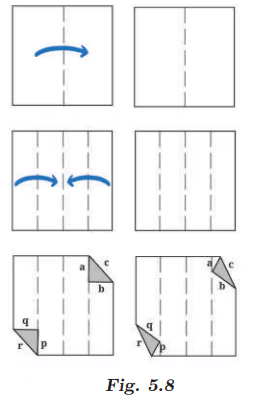
Q1: Are a, b, and c parallel to p, q, and r respectively? Why or why not?
Ans: Yes, a, b, and c are parallel to p, q, and r respectively because each triangle was folded exactly along the crease lines. Since the folds and the crease lines go in the same direction, they are parallel.
Page No. 113
Figure it Out
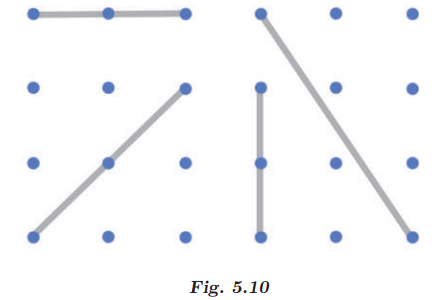
Q1: Draw some lines perpendicular to the lines given on the dot paper in Fig. 5.10.Ans: Draw lines that intersect the given lines at 90° angles, using a set square or protractor to ensure right angles. Do it Yourself.
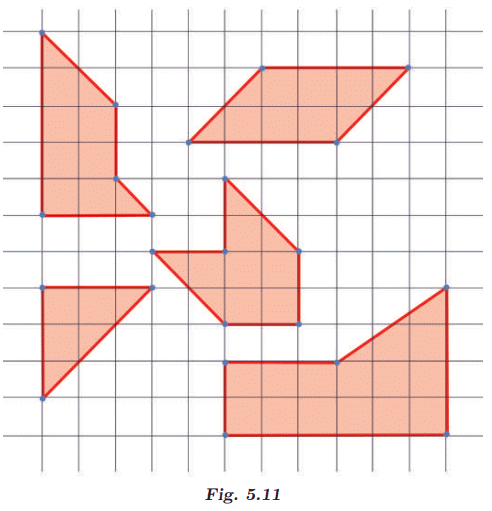
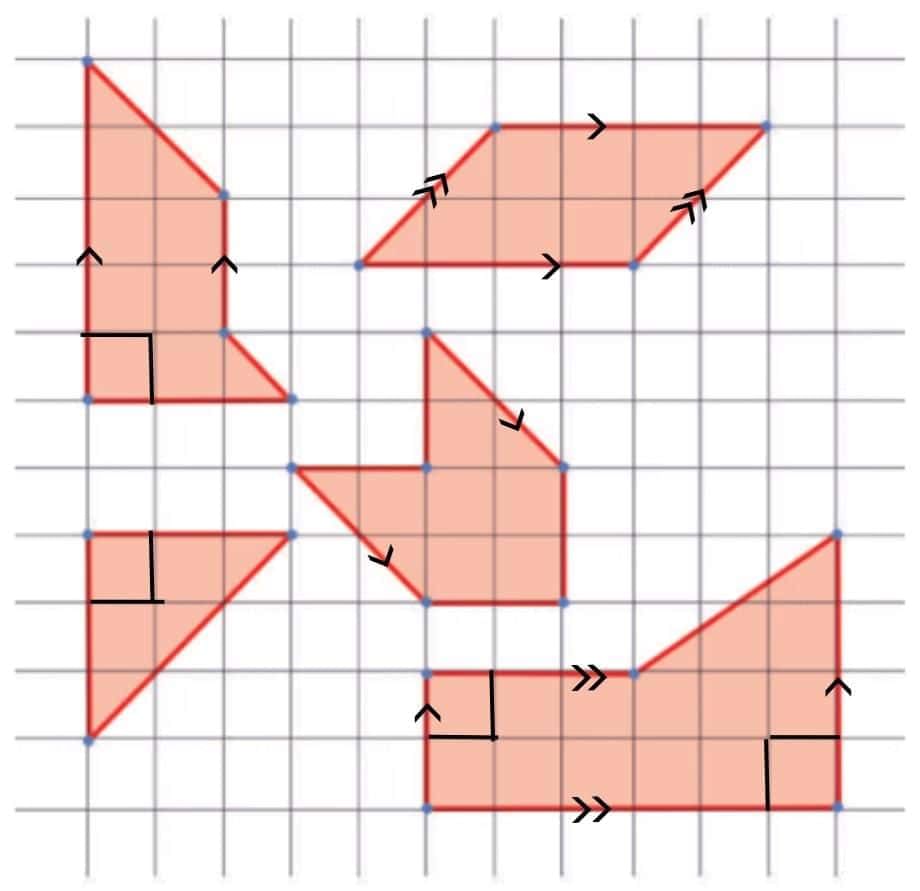
Q2: In Fig. 5.11, mark the parallel lines using the notation given above (single arrow, double arrow etc.). Mark the angle between perpendicular lines with a square symbol.(a) How did you spot the perpendicular lines?
Ans: Perpendicular lines form 90° angles, identified by measuring or using a set square. Mark with a square symbol.
(b) How did you spot the parallel lines?
Ans: Parallel lines have equal corresponding angles with a transversal or appear equidistant and non-intersecting. Mark with single or double arrows for different sets.
Try to find more parallel lines in the given diagram.
Q3: In the dot paper following, draw different sets of parallel lines. The line segments can be of different lengths but should have dots as endpoints.
Ans: Do it yourself.
Page No. 114
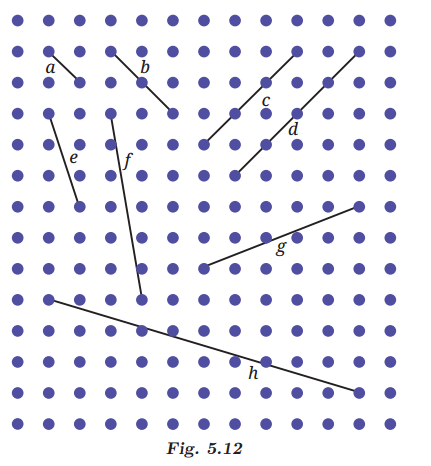
Q1: Using your sense of how parallel lines look, try to draw lines parallel to the line segments on this dot paper.(a) Did you find it challenging to draw some of them?
(b) Which ones?
(c) How did you do it?
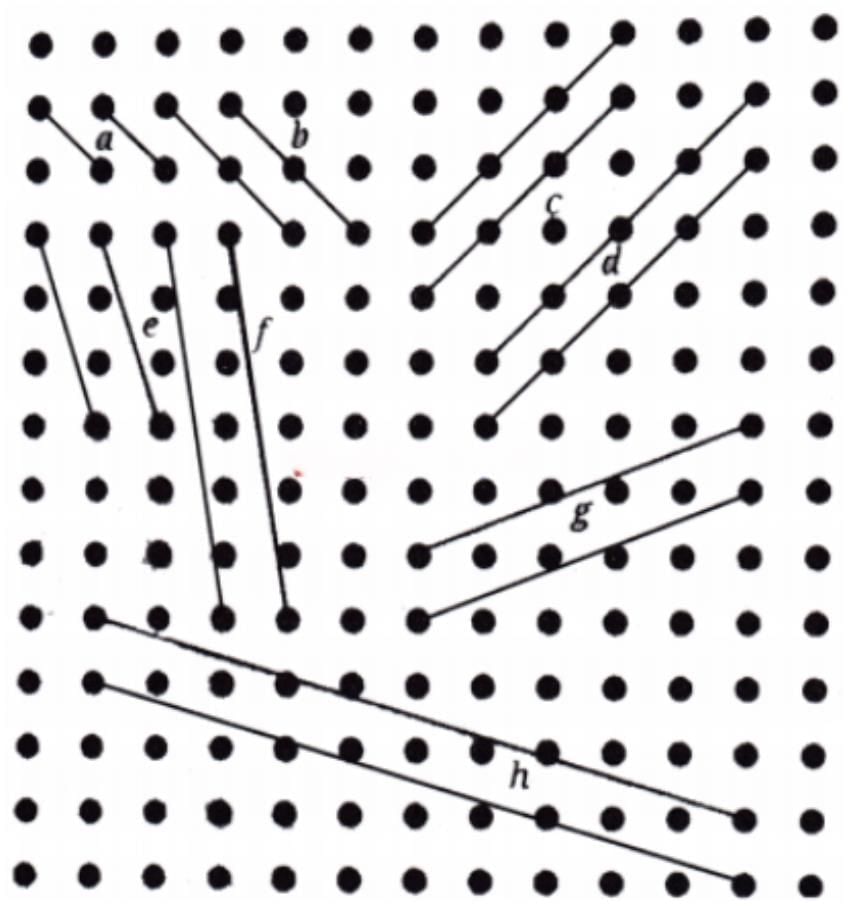
Ans:
(a) – (c): Do it Yourself.
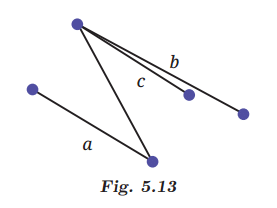
Q2: In Fig. 5.13, which line is parallel to line a – line b or line c? How do you decide this?Ans: In the given figure, line a is parallel to line c because these two lines are always the same distance apart and never meet, no matter how far they go.
Page No. 115
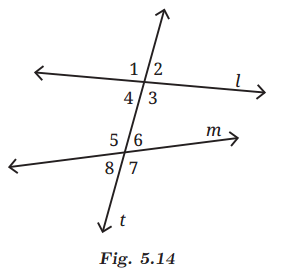
In Fig. 5.14, line t intersects lines l and m. t is called a transversal. Notice that 8 angles are formed when a line crosses a pair of lines.
Q1: Is it possible for all the eight angles to have different measurements? Why, why not?
Ans: No, all eight angles cannot have different measurements. Vertically opposite angles are equal, so there are at most four distinct angle measures.
Q2: What about five different angles – 6, 5, 4, 3, and 2?
Ans: Five different angles are not possible, as vertically opposite angles must be equal, limiting the number of distinct angles to four.
Page No. 117
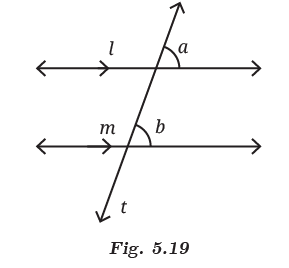
Q1: Fig. 5.19 has a pair of parallel lines l and m. What is the notation used in the figure to indicate they are parallel?
Ans: The notation is a single arrow mark (>) on both lines l and m.
Q2: Are all the corresponding angles equal to each other?
Ans: Yes, all corresponding angles are equal when a transversal intersects parallel lines.
Page No. 119 & 120
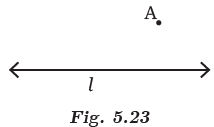
Q1: Can you draw a line parallel to l, that goes through point A? How will you do it with the tools from your geometry box? Describe your method.
Ans: Tools Needed:
- Ruler
- Set Squares
- Pencil
Step-by-Step Procedure:
- Place the set square so that one side is along the line l.
- Hold the ruler against the other side of the set square (the ruler won’t move).
- Slide the set square along the ruler until one side reaches point A.
- Draw a line along the edge of the set square through point A.
- This new line is parallel to line l and passes through point A.
Let us try to do the same with paper folding. For a line l (given as a crease), how do we make a line parallel to l such that it passes through point A?
We know how to fold a piece of paper to get a line perpendicular to l. Now, try to fold a perpendicular to l such that it passes through point A. Let us call this new crease t.
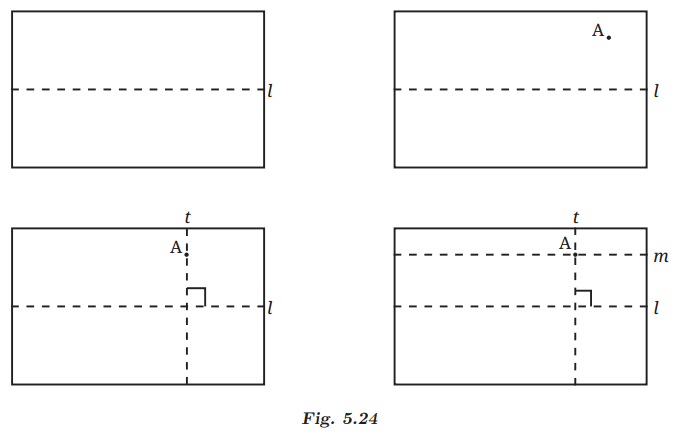
Now, fold a line perpendicular to t passing through A again. Let us call this line m. The lines l and m are parallel to each other. l
Q: Why are lines l and m parallel to each other?
Ans: Line t is perpendicular to line l; line m is also perpendicular to line t. Thus, if two lines are perpendicular to the same line, they are parallel to each other. Thus, lines l and m are parallel to each other because they share the same perpendicular relationship with line t.
Page 120
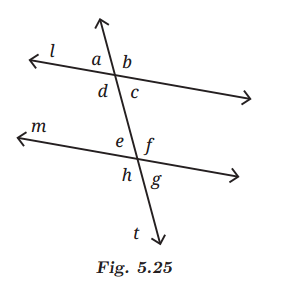
Q1: In Fig. 5.25, if ∠f is 120°, what is the measure of its alternate angle ∠d?Ans: ∠d = 120°, because ∠d is the vertically opposite angle to ∠b, which is the corresponding angle to ∠f, and both are equal to 120°.
Page 123 & 124
Figure it Out
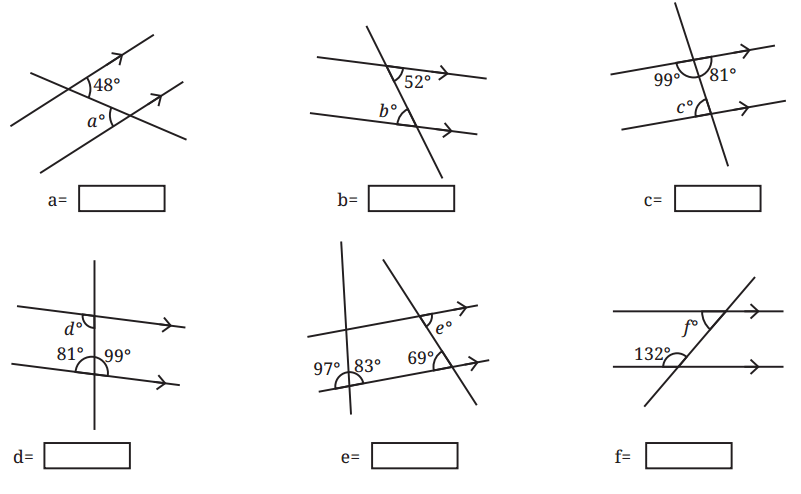
Q1: Find the angles marked below.
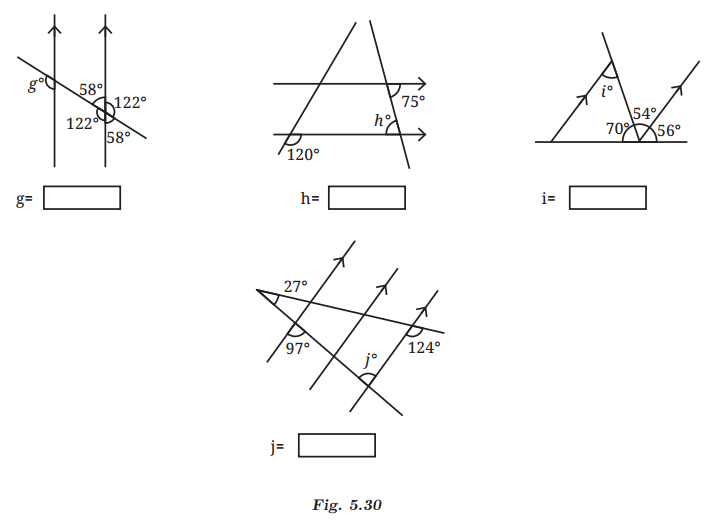
Ans:
(a) Find the angle marked in figure a.
Ans: a is equal to 48°. (Alternate angles are equal)
(b) Find the angle marked in figure b.
Ans: b is equal to 52°. (Alternate angles are equal)
(c) Find the angle marked in figure c.
Ans: In figure c, one angle is 99°. The angles are adjacent on a straight line, so they add up to 180°. The unknown angle is 180° – 99° = 81°. So, the angle is 81°.
(d) Find the angle marked in figure d.
Ans: d = 99°. (Alternate angles are equal)
(e) Find the angle marked in figure e.
Ans: e = 69°. (Alternate angles are equal)
(f) Find the angle marked in figure f.
Ans: In figure f, one angle is 132°. The unknown angle is 180° – 132° = 48°. So, the angle is 48°. ( Co-interior angles)
(g) Find the angle marked in figure g.
Ans: g = 122°. (Transversal crossing parallel lines so corresponding angles are equal)
(h) Find the angle marked in figure h.
Ans: h = 75°. (Alternate angles are equal)
(i) Find the angle marked in figure i.
Ans: Alternate interior angles formed by a transversal intersecting a pair of parallel lines are always equal to each other. Therefore, i = 54°.
(j) Find the angle marked in figure j.
Ans: Alternate interior angles formed by a transversal intersecting a pair of parallel lines are always equal to each other. Therefore, j = 97°.
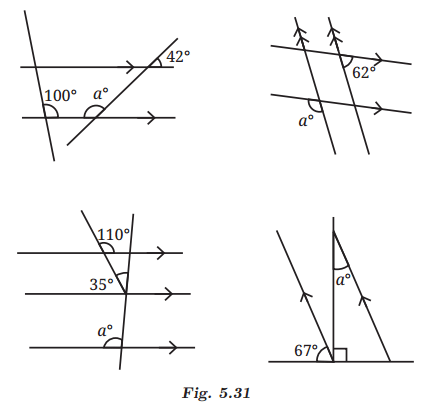
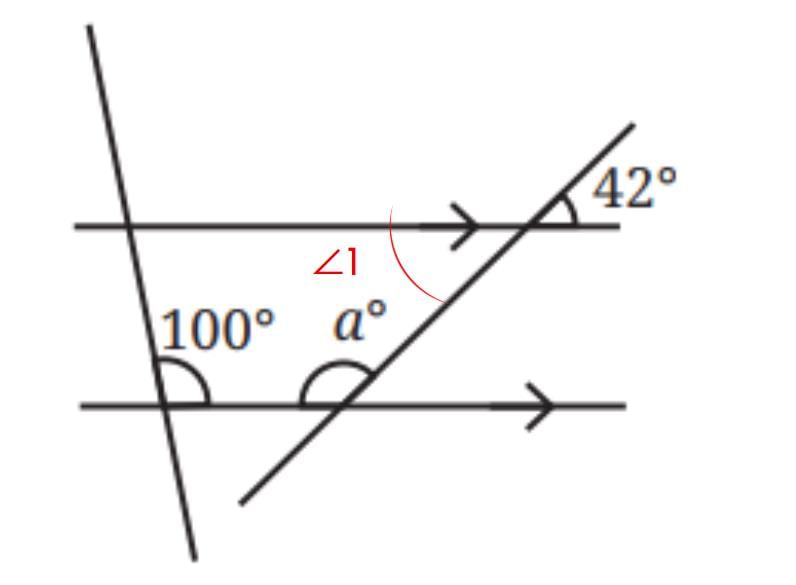
Q2: Find the angle represented by a.Ans:
∠1 = 42° ( Vertically opposite angles)
42° + a° = 180° ( Co-interior angles)
⇒ a° = 180° – 42°
⇒ a° = 138°
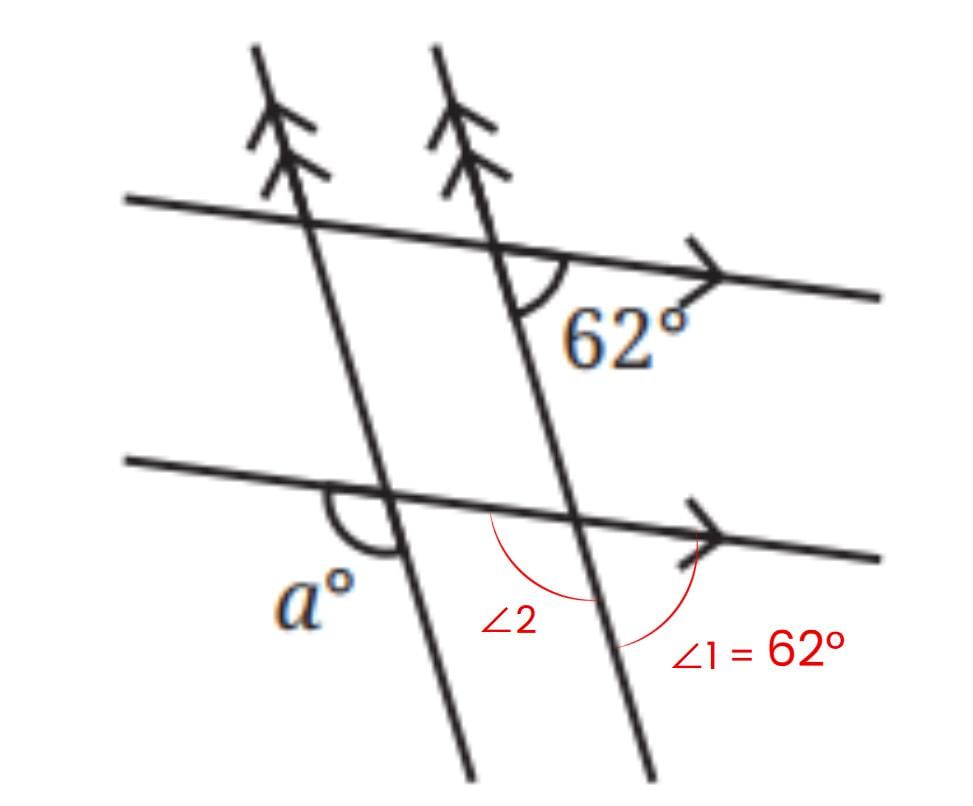
∠1 = 62° (Corresponding angles are equal)
∠1 + ∠2 = 180° ( Linear Pair)
⇒ 62° + ∠2 = 180°
⇒ ∠2 = 118°
Now, a° = 118° (Corresponding angles are equal)
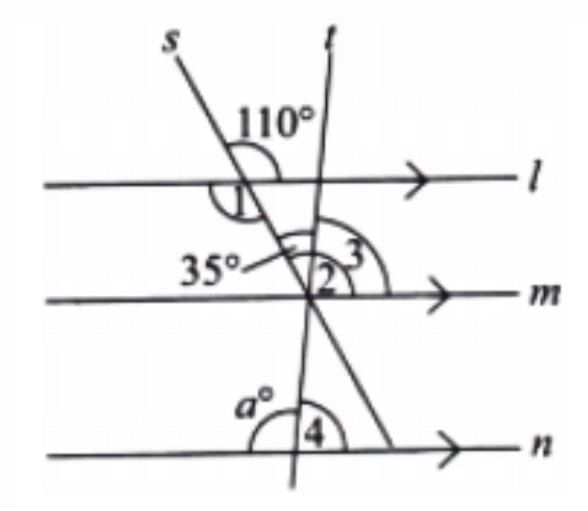
Here, lines s and l are intersecting lines.
So, ∠1 = 110° [Vertically opposite angles]
And ∠1 = ∠2 = 110° because lines l and m are parallel and line s is a transversal.
Therefore ∠3 = ∠2 – 35° = 110° – 35° = 75°
Also, ∠3 = ∠4 = 75° [Corresponding angles]
So, a° = 180° – 75° = 105° [Linear pair angles]
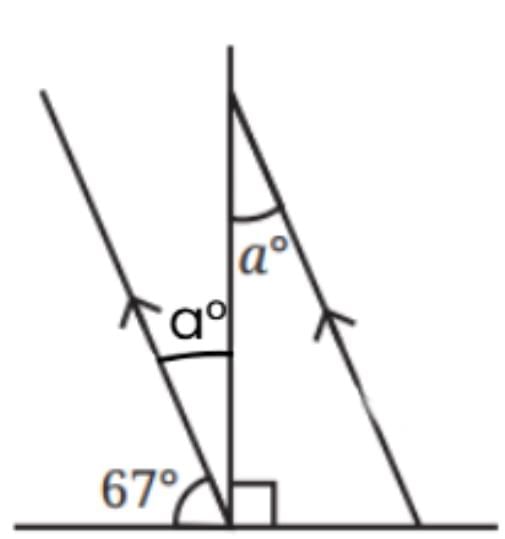
⇒ 67° + aº + 90° = 180° ( Using angles on a straight line)
⇒ a°= 23° ( Also, alternate angles are equal).
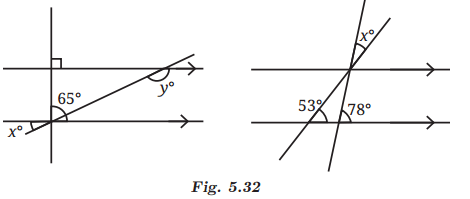
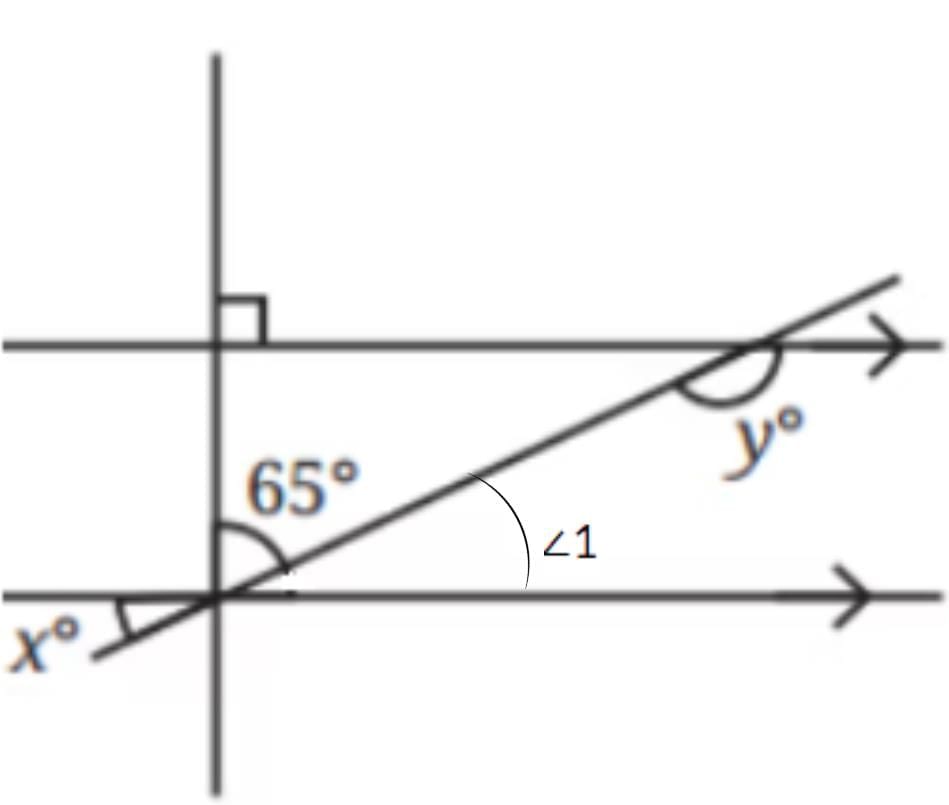
Q3: In the figures below, what angles do x and y stand for in Fig. 5.32?Ans:In Fig. 5.32 (left), there is the correction in the image.
∠1 = xº ( Alternate angles)
∠1 + 65° = 90° ( Linear Pair)
⇒ xº + 65° = 90°
⇒ xº = 25°
xº + y = 180° ( Co-interior angles)
⇒ y = 180° – 25° = 155°
In Fig. 5.32 (right),
∠1 = xº ( Vertically opposite angles)
∠2 + 78° = 180° ( Linear Pair)
∠2 = 102°
Now, In triangle ABC,
∠1 + ∠2 + 53° = 180° ( Angle sum property of triangle)
⇒ x + 102° + 53° = 180°
⇒ x = 25°
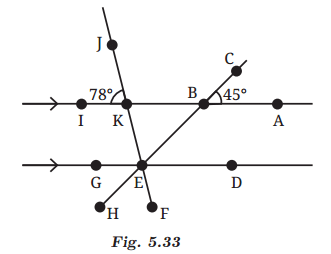
Q4: In Fig. 5.33, ∠ABC = 45° and ∠IKJ = 78°. Find angles ∠GEH, ∠HEF, ∠FED.Ans: ∠ GEH = 45° ( Exterior alternate angles)
∠ FED = 78° (Exterior alternate angles)
So, ∠ GEH + ∠ HEF + ∠ FED = 180° ( all lie on a straight line)
⇒ 45° +∠ HEF + 78° = 180°
⇒ ∠ HEF = 57°
Page No. 125
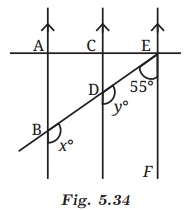
Q5: In Fig. 5.34, AB is parallel to CD and CD is parallel to EF. Also, EA is perpendicular to AB. If ∠BEF = 55°, find the values of x and y.Ans: yº + 55° = 180° ( Co-interior angles)
⇒ yº = 180° – 55° = 125°
Also, xº = yº ( Corresponding angles)
⇒ xº = yº = 125°
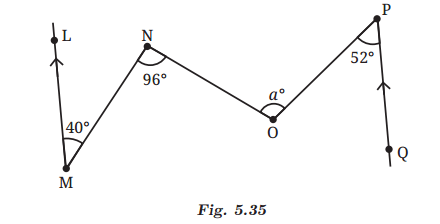
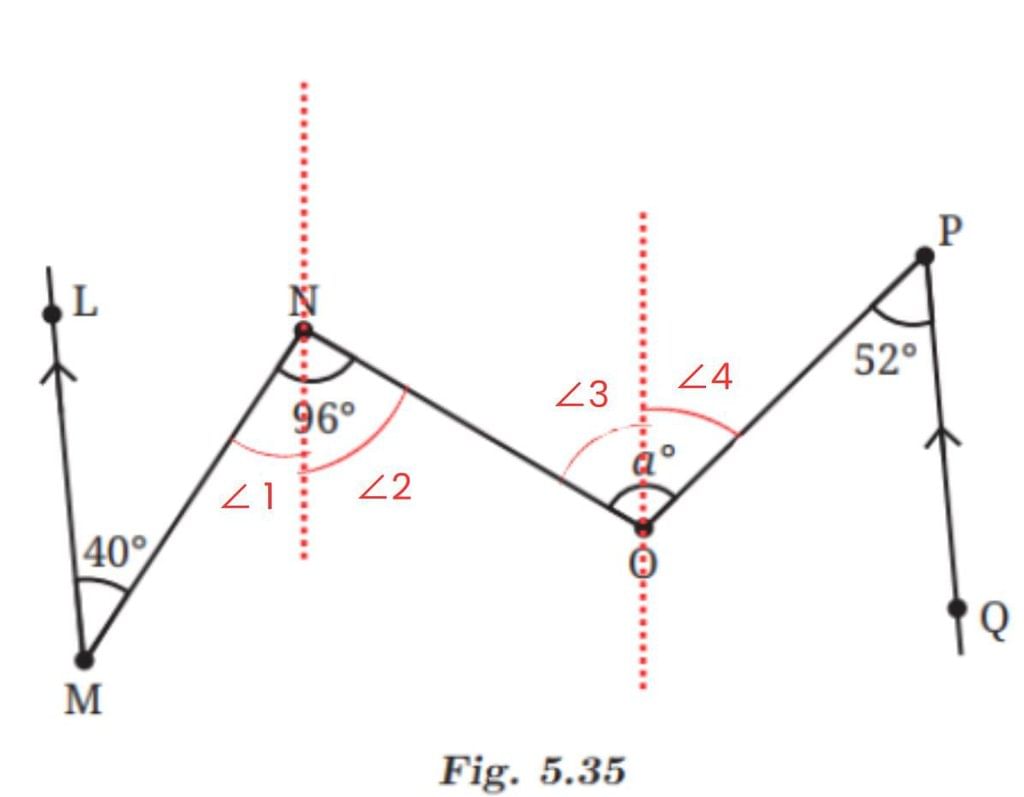
Q6: What is the measure of angle ∠NOP in Fig. 5.35? [Hint: Draw lines parallel to LM and PQ through points N and O.]Ans: ∠ 1 = 40° ( Alternate angles are equal)
∠2 = 90° – 40° = 56°
∠3 = 56° ( Alternate angles are equal)
∠4 = 52° ( Alternate angles are equal)
So, a = 56° + 52° = 108°
Parallel Illusions
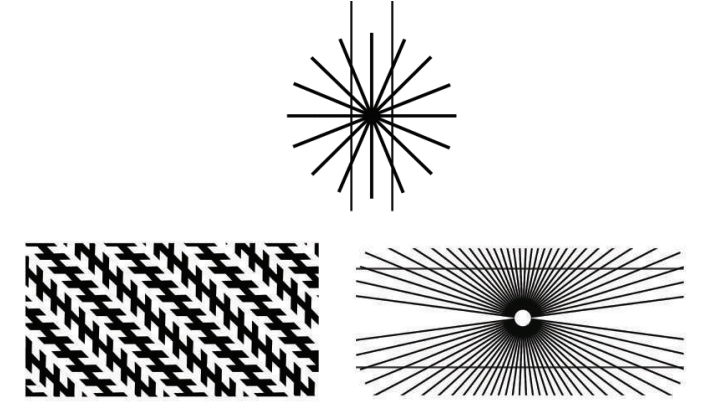
Q1: There do not seem to be any parallel lines here. Or, are there?
What causes these illusions?
Ans: (a) At first glance, this image may appear to be a confusing mix of lines going in all directions, giving the impression that nothing is straight or parallel. However, if we take a closer look, we can see that the vertical lines are perfectly straight, evenly spaced, and are parallel. In contrast, the other lines in the image fan out like spokes on a wheel. These lines are not parallel; they are slanted and converge at a central point. Due to their orientation and the way they intersect with the vertical lines, our brains can become misled. This phenomenon is known as an optical illusion. It occurs because the slanted lines create a sensation that everything is angled or distorted. The focal point in the centre draws our attention and makes it difficult to concentrate on the vertical lines.
(b) This pattern appears to be filled with tilted or zigzagging lines, and the black shapes create a confusing background. However, if we look closely at the white spaces in between, we can see that the horizontal white lines are parallel. So why do they not seem that way? The bold, slanted black shapes visually interrupt the lines, causing our eyes to perceive them as slanting or shifting. This phenomenon is known as an optical illusion—our brain interprets the shapes around the lines, leading us to see something that isn’t there.
(c) When you first look at this picture, it appears that nothing is parallel. The lines seem bent, the shape appears to curve inward, and everything feels like it’s being pulled toward the centre. However, the two horizontal lines at the top and bottom of the image are parallel! This is a classic optical illusion. It occurs because of the many diagonal lines radiating from a central point, resembling the spokes of a wheel. These radiating lines distort our perception, leading our brains to interpret the space as curved due to the way the lines fan out from the centre, creating a sense of depth. As a result, the ends of the horizontal lines seem to bend, even though they are perfectly straight. This visual trick deceives our eyes into believing that the horizontal lines are curving inward, but if we measure them or place a ruler along them, we can see that they are straight and parallel.